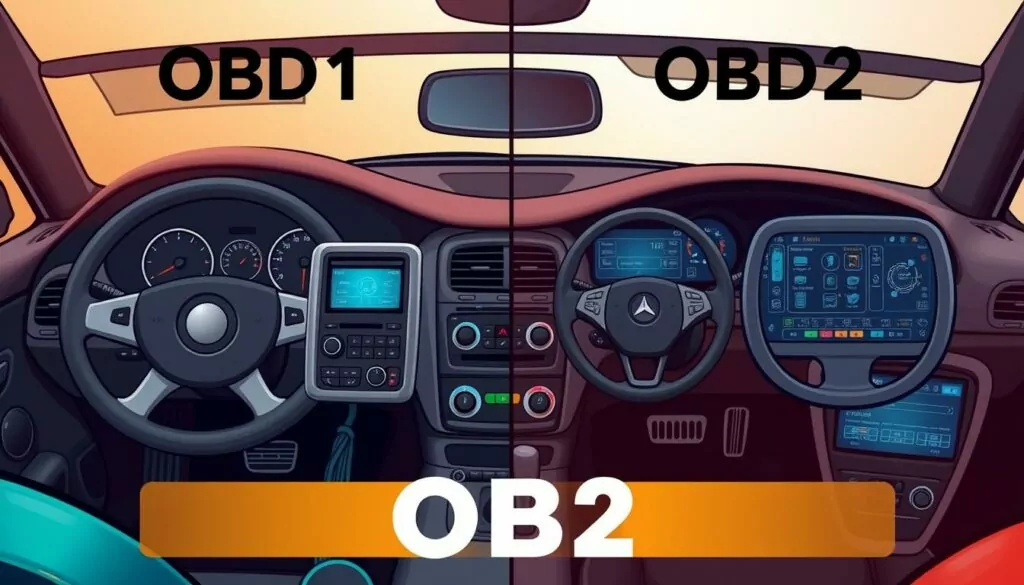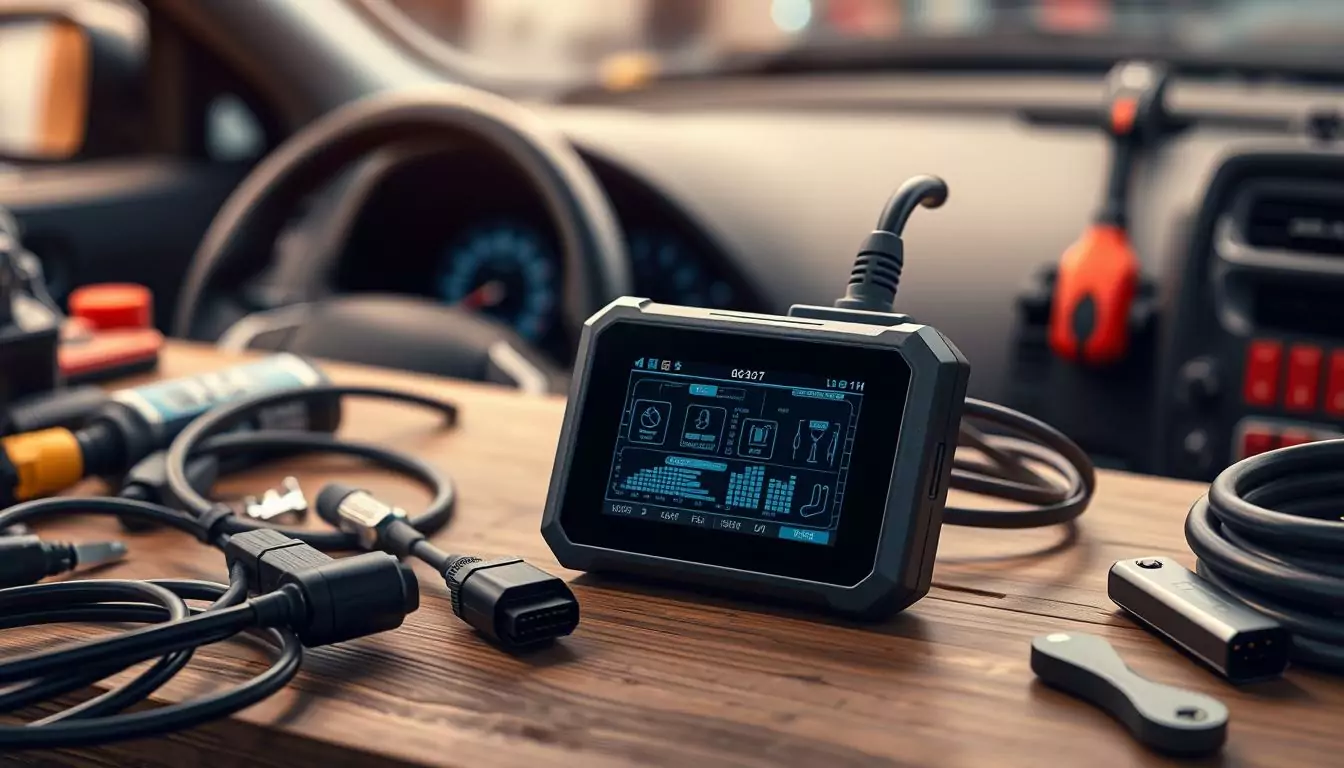I’ve always been drawn to the world of on-board diagnostics (OBD) and the tools that explore our vehicles’ inner workings. OBD scanners, like the advanced OBD2 models, are key in today’s cars. They plug into the OBD2 port and give us vital info for keeping our cars running well.
OBD2 scanners let us see into our cars’ systems. They show us real-time data, help us understand trouble codes, and check many important car functions. These tools have changed how we care for and fix our cars.
Key Takeaways
- OBD2 scanners connect directly to a car’s systems, giving us lots of useful info for upkeep and fixes.
- They can read and clear trouble codes, helping us find and fix car problems.
- OBD2 scanners let us check many car functions, like engine performance and emissions.
- Wireless OBD2 scanners that connect to phones are getting more popular, making things easier and more convenient.
- OBD2 scanners are important for keeping cars running smoothly and saving on repair costs, giving car owners important diagnostic info.
Introduction to OBD and OBD2 Scanners
OBD, or on-board diagnostics, is a system in cars that checks and controls different parts. It gives access to important data. Starting in 1994, OBD systems were needed in light vehicles. OBD-II became a must for cars from 1996 on. Heavy duty vehicles needed OBD from 2005.
What is OBD?
OBD was created in the U.S. to cut down air pollution from cars in big cities. The California Air Resources Board made OBD a rule for all cars in 1991. OBD-II became the standard for the whole country in 1996.
Evolution of OBD2 Scanners
OBD-II uses a 16-pin connector for diagnostics, with Type A for 12V and Type B for 24V vehicles. It has codes like Pxxxx for engine problems and Bxxxx for body issues. For example, P0112 means intake air temperature is low, and P0710 means the transmission fluid sensor is faulty.
OBD-II uses a 16-pin DLC for getting trouble codes. Early systems used a few pins, but now they use CAN protocol for faster data. Some cars even use FlexRay for their ESC systems.
General Motors made the first computerized diagnostic link in 1980. But, OBD-I wasn’t the same for all cars, making tools work only for one brand. OBD 1.5 was used by GM from 1994 to 1995, and OBD-II made codes standard for engines and emissions.
The United Nations made WWH-OBD standards as part of GTR to improve OBD-II.
How OBD2 Scanners Work

OBD2 scanners are key for figuring out and fixing car problems. They connect the car’s computer to the user, giving lots of info for upkeep and fixes.
Connecting to the OBD2 Port
To start using an OBD2 scanner, find the OBD2 port. It’s usually in the driver’s area, hidden behind the dashboard or steering column. Plug the scanner in to talk directly to the car’s computer units.
Reading and Clearing Error Codes
Once plugged in, the scanner checks the car’s trouble codes stored in the computer. These codes tell you about any problems or issues. The scanner shows these codes, helping you find and fix the problem. Some codes might need more checking, but the scanner’s key role is in reading and clearing them.
Monitoring Vehicle Performance
OBD2 scanners also let you watch the car’s performance in real-time. You can see things like engine load, coolant temperature, and fuel use. This info helps keep the car running well and catch problems early.
OBD2 tech has changed how we check and care for our cars. It gives a simple way to get important car data. With OBD2 scanners, car owners and mechanics can fix problems faster and keep cars running longer.
| OBD2 Scanner Cost | Mechanic Diagnostic Fee | Advantages of OBD2 Scanners |
|---|---|---|
| Around $60 for basic models | $100 or more for most vehicles |
|
OBD2 technology has revolutionized the way we diagnose and maintain our vehicles, providing a standardized, user-friendly interface to access critical vehicle data.”
OBD2 tech has been a big step forward in car care and fixing. It offers a standard way to get car data, making it a must-have for DIY fans and mechanics. It helps find and fix problems quickly, saving money and keeping cars running better.
Common OBD2 Error Codes and Their Meanings
It’s important to know about OBD2 error codes for fixing cars right. These codes have a standard format, with a letter and four numbers. They tell us about the car’s systems and problems.
Understanding Error Codes
OBD2 error codes fall into four main groups: Powertrain (P-codes), Chassis (C-codes), Body (B-codes), and Network & Vehicle Integration (U-codes). Codes starting with ‘0’ are general, while ‘1’ codes are specific to the car maker. They help us find the main problem quickly.
Most Frequently Encountered Codes
Many common codes deal with the car’s engine and transmission. Chassis codes might show brake or steering issues. Body codes often point to problems with lights or airbags. Knowing these codes helps fix cars fast.
Interpreting Codes for Accurate Diagnosis
To understand OBD2 error codes, you need to know the code structure and the car’s systems. The first letter tells us which system is affected. The second letter shows if it’s a standard or specific code. The third letter narrows it down to a subsystem.
The fourth and fifth numbers tell us exactly what’s wrong. This helps technicians fix the problem quickly. Using tools like OBD2 scanners gives more details for better fixes. Knowing the latest about OBD2 helps car experts do their job better.
OBD1 vs OBD2

The car world has changed a lot with on-board diagnostics (OBD) technology. OBD1 came out in the early 1990s but wasn’t the same for all cars. This made fixing cars harder because each brand had its own system.
OBD1
OBD1 mainly checked if cars were polluting too much and was used until the mid-1990s. It was simple and only looked at pollution, not much else.
OBD2
OBD2 started in 1994 and made all new cars from 1996 on use the same system. This made fixing cars easier because one tool worked for all cars. OBD2 also had better pollution control than OBD1.
Advantages of OBD2 over OBD1
OBD2 checks more parts of a car than OBD1. It looks at the engine, emissions, and even safety features like airbags. OBD2 also uses a special network called CAN for easy communication.
OBD2 tools work with all cars because they have a standard connector. This makes them easy to use for anyone fixing cars.
| Feature | OBD1 | OBD2 |
|---|---|---|
| Standardization | Proprietary systems, lack of standardization | Mandated by regulation, standardized 16-pin connector |
| Diagnostic Capabilities | Basic, focused on emission control systems | Comprehensive, monitors engine, emission, transmission, ABS, airbags |
| Communication Protocol | Varied, brand/model-specific | Standardized CAN (Controller Area Network) |
| Compatibility | Brand/model-specific scan tools required | Universal compatibility across vehicle makes and models |
In short, moving from OBD1 to OBD2 has made car repairs better. It’s more standard, covers more, and is easier to use for everyone.
Future of OBD Technology in Automobiles
The future of OBD (On-Board Diagnostics) technology is exciting and transformative. OBD2, which became the standard in the late 1990s, is key in modern cars. It gives real-time engine data and detailed trouble codes to car owners.
Advanced diagnostics for electric and hybrid vehicles are on the horizon. These vehicles use UDS (Unified Diagnostic Services) communication, making data decoding hard without reverse engineering. New systems like WWH-OBD and OBDonUDS are being developed, using UDS as a base.
Enhanced Connectivity Features
Connected cars are becoming more common, leading to plans to control OBD2 data in a central server. This would allow for remote diagnostics and updates. It would make car maintenance more efficient and proactive.
Remote Diagnostics and Over-the-Air Updates
Remote diagnostics and updates are expected to be part of OBD technology’s future. OBD2 Bluetooth scanners have already improved diagnostics. They now support live data streaming, freeze frame analysis, and emission status monitoring.
OBD technology is driving the automotive industry forward, making OBD2 essential in modern cars. The market for automotive OBD II Scan Tools is growing fast, with a CAGR of 12.8% from 2024 to 2031. North America, mainly the United States, will lead the market, with about 40% of the share.
The automotive industry is innovating, and OBD technology is at the forefront. It promises better diagnostics, connectivity, and maintenance solutions. These advancements will benefit car owners and the industry as a whole.
FAQ
What is an OBD2 scanner and how does it work?
An OBD2 scanner is a tool that connects to your car’s OBD2 port. This port is usually under the dashboard. It lets you see error codes, check live data, and find problems with your car’s systems.
What is the difference between OBD1 and OBD2?
OBD1 was the first system for checking cars, but it wasn’t standard. Each car maker had its own system. OBD2, introduced in 1994, made all new cars from 1996 on use the same system. This means one scanner can work on many different cars.
How do I connect an OBD2 scanner to my vehicle?
First, find the OBD2 port in your car. It’s often under the dashboard or behind the steering column. Then, just plug the scanner into it. It will connect to your car’s system.
What do the error codes from an OBD2 scanner mean?
OBD2 error codes have a standard format. They give clues about problems found by your car’s sensors. Knowing what these codes mean helps you fix issues more easily.
Can an OBD2 scanner be used on any vehicle?
While OBD2 is standard, not all scanners work with every car. Make sure to pick a scanner made for your car’s make, model, and year. This ensures it works fully and gives you all the data you need.
What kind of live data can I access with an OBD2 scanner?
OBD2 scanners let you see live data like engine load, coolant temperature, and fuel use. This data helps you understand how your car is doing and how it’s performing.
Source Links
- How OBD2 Technology is Revolutionizing Car Maintenance –https://www.ancel.com/blogs/news/obd2-technology-revolutionizing-car-maintenance
